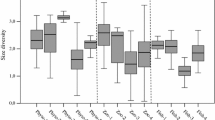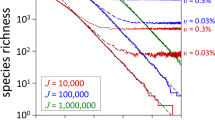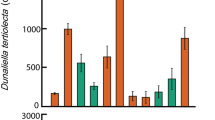Abstract
I examine several hypotheses for competitive dominance among zooplankton using data from 20 studies containing field and laboratory experiments on competition between cladoceran species.
In threeDaphnia species from rockpools studied in the laboratory, the largeD. magna was the superior competitor at higher food levels and at 15°, while the smallerD. pulex andD. longispina were dominants at low food levels at 20°.D. pulex usually excludedD. longispina. No single-factor hypothesis gives a satisfying explanation for these results.
A review of the literature data suggests that none of the following hypotheses for competitive dominance have sufficient support to be considered general: The size-efficiency hypothesis (supported in 60% of the tests), ther-max hypothesis (68% support), efficiency at low food levels (36% support), and that small species are superior competitors (only 17% support). Competitive ability and susceptibility to predation appear to be positively related (9 out of 10 cases). 76% of the experiments carried out under different environmental conditions showed varying outcomes. Competition between cladocerans should evidently be studied within a multi-factor framework.
Since shifts in competitive advantage with environmental changes were common, the competitive exclusion principle may often not apply in zooplankton assemblages. Non-equilibrium coexistence of competitors in a variable environment, i.e. the paradox of the plankton, is a framework worthy of consideration in zooplankton, and possibly also in many other natural communities.
Similar content being viewed by others
References
Abrams, P., 1980. Are competition coefficients constant? Inductive versus deductive approaches. Am. Nat. 116: 730–735.
Abrams, P., 1984. Variability in resource consumption rates and the coexistence of competing species. Theor. Popul. Biol. 25: 106–124.
Allan, J. D., 1974. Balancing predation and competition in cladocerans. Ecology 55: 622–629.
Bengtsson, J., 1986. Life histories and interspecific competition between threeDaphnia species in rockpools. J. anim. Ecol. 55: 641–655.
Brooks, J. L. & S. I. Dodson, 1965. Predation, body size, and the composition of plankton. Science 150: 28–35.
Caswell, H., 1978. Predator-mediated coexistence: A none-quilibrium model. Am. Nat. 112: 127–154.
Connell, J. H., 1983. On the prevalence and relative importance of interspecific competition: Evidence from field experiments. Am. Nat. 122: 661–696.
Cooper, S. D. & D. W. Smith, 1982. Competition, predation and the relative abundances of two species ofDaphnia. J. Plankton Res. 4: 859–879.
De Bernardi, R., 1979a. Some problems in the study of population dynamics of zooplankton. Boll. zool. ital. 46: 179–189.
De Bernardi, R., 1979b. An experimental approach to the interspecific competition between two species ofDaphnia: D. hyalina andD. pulicaria (Crustacea). Věst. Čes. spol. zool. 43: 81–93.
DeMott, W. R., 1983. Seasonal succession in a naturalDaphnia assemblage. Ecol. Monogr. 53: 321–340.
DeMott, W. R. & W. C. Kerfoot, 1982. Competition among cladocerans: Nature of the interaction betweenBosmina andDaphnia. Ecology 63: 1949–1966.
Dodson, S. I., 1974. Zooplankton competition and predation: An experimental test of the size-efficiency hypothesis. Ecology 55: 605–613.
Frank, P. W., 1952. A laboratory study of intraspecies and interspecies competition inDaphnia pulicaria (Forbes) andSimocephalus vetulus (O. F. Müller). Physiol. Zool. 25: 178–204.
Frank, P. W., 1957. Coactions in laboratory populations of two species ofDaphnia. Ecology 38: 510–519.
Gerritsen, J., 1984. Size efficiency reconsidered: A general foraging model for free-swimming aquatic animals. Am. Nat. 123: 450–467.
Ghilarov, A. M., 1984. The paradox of the plankton reconsidered; or, why do species coexist? Oikos 43: 46–52.
Gliwicz, Z. M., 1980. Filtering rates, food size selection, and feeding rates in cladocerans — Another aspect of interspecific competition in filter-feeding zooplankton. In W. C. Kerfoot (ed.), Evolution and Ecology of Zooplankton Communities. The University Press of New England, Hanover (N.H.); Lond.: 282–291.
Good, A. R., 1981. The ecology and biogeography of tundra zooplankton communities in the Churchill, Manitoba area. M.S. Thesis, University of Windsor, Ontario, Canada.
Goulden, C. E., L. L. Henry & A. J. Tessier, 1982. Body size, energy reserves, and competitive ability in three species of Cladocera. Ecology 63: 1780–1789.
Goulden, C. E., L. Hornig & C. Wilson, 1978. Why do large zooplankton species dominate? Ver. int. Ver. Limnol. 20: 2457–2460.
Hall, D. J., S. T. Threlkeld, C. W. Burns & P. H. Crowley, 1976. The size-efficiency hypothesis and the size structure of zooplankton communities. Ann. Rev. Ecol. Syst. 7: 177–208.
Hanski, I. & E. Ranta, 1983. coexistence in a patchy environment: Three species ofDaphnia in rock pools. J. anim. Ecol. 52: 263–279.
Hebert, P. D. N., 1977. Niche overlap among species in theDaphnia carinata complex. J. anim. Ecol. 46: 399–409.
Hebert, P. D. N., 1978. The population biology ofDaphnia (Crustacea, Daphnidae). Biol. Rev. 53: 387–426.
Hebert, P. D. N., 1982. Competition in zooplankton communities. Ann. zool. fenn. 19: 349–356.
Hebert, P. D. N. & T. J. Crease, 1980. Clonal coexistence inDaphnia pulex (Leydig): Another planktonic paradox. Science 207: 1363–1365.
Hrbáčková-Esslová, M., 1963. The development of three species ofDaphnia in the surface water of the Slapy reservoir. Int. Revue ges. Hydrobiol. 48: 325–333.
Hutchinson, G. E., 1961. The paradox of the plankton. Am. Nat. 95: 137–145.
Jacobs, J., 1978. Coexistence of similar zooplankton species by differential adaptation to reproduction and escape in an environment with fluctuating food and enemy densities. III. Laboratory experiments. Oecologia (Berl.) 35: 35–54.
Kerfoot, W. C., 1977. Competition in cladoceran communities: The cost of evolving defences against copepod predation. Ecology 58: 303–313.
Kerfoot, W. C. & R. A. Pastorok, 1978. Survival versus competition: evolutionary compromises and diversity in the zooplankton. Verh. int. Ver. Limnol. 20: 362–374.
Lampert, W. & U. Schober, 1980. The importance of ‘threshold’ food concentrations. In W. C. Kerfoot (ed.), Evolution and Ecology of Zooplankton Communities. The University Press of New England, Hanover (N.H.); Lond.: 264–267.
Levins, R. 1979. Coexistence in a variable environment. Am. Nat. 114: 765–783.
Loaring, J. M. & P. D. N. Hebert, 1981. Ecological differences among clones ofDaphnia pulex Leydig. Oecologia (Berl.) 51: 162–168.
Lynch, M., 1978. Complex interactions between natural coexploiters —Daphnia andCeriodaphnia. Ecology 59: 552–564.
Lynch, M., 1979. Predation, competition and zooplankton community structure: An experimental study. Limnol. Oceanogr. 24: 253–272.
Lynch, M., 1980a. The evolution of cladoceran life histories. Quart. Rev. Biol. 55: 23–42.
Lynch, M., 1980b. Predation, enrichment, and the evolution of cladoceran life histories: A theoretical approach. In W. C. Kerfoot (ed.), Evolution and Ecology of Zooplankton Communities. The University Press of New England, Hanover (N.H.), Lond.: 367–376.
Matveev, V., 1983. Estimating competition in cladocerans using data on dynamics of clutch size and population density. Int. Revue ges. Hydrobiol. 68: 785–798.
Murray, B. G., Jr. & L. Gárding, 1984. On the meaning of the parameterx of Lotka's discrete equations. Oikos 42: 323–326.
Neill, W. E., 1974. The community matrix and interdependence of the competition coefficients. Am. Nat. 108: 399–408.
Neill, W. E., 1975. Experimental studies on microcrustacean competition, community composition and efficiency of resource utilization. Ecology 56: 809–826.
Neill, W. E., 1978. Experimental studies on factors limiting colonization byDaphnia pulex Leydig of coastal montane lakes in British Columbia. Can. J. Zool. 56: 2498–2507.
Noy-Meir, I., 1981. Theoretical dynamics of competitors under predation. Oecologia (Berl.) 50: 277–284.
Ranta, E., 1979. Niche ofDaphnia species in rock pools. Arch. Hydrobiol. 87: 205–223.
Ricklefs, R. E., 1980. Ecology. 2nd edition. Nelson, Sunbury-on-Thames, Great Britain.
Romanovsky, Y. E., 1984. Individual growth rate as a measure of competitive advantages in cladoceran Crustaceans. Int. Revue. ges. Hydrobiol. 69: 613–632.
Romanovsky, Y. E. & I. Y. Feniova, 1985. Competition among Cladocera: effect of different levels of food supply. Oikos 44: 243–252.
Roughgarden, J., 1979. Theoretical population genetics and evolutionary ecology: An introduction. MacMillan, New York.
Schoener, T. W., 1974. Resource partitioning in ecological communities. Science 185: 27–39.
Schoener, T. W., 1983. Field experiments on interspecific competition. Am. Nat. 122: 240–285.
Siegel, S., 1956. Non-parametric statistics for the behavioural sciences. McGraw-Hill, Tokyo.
Smith, D. W. & S. D. Cooper, 1982. Competition among Cladocera. Ecology 63: 1004–1015.
Sokal, R. R. & F. J. Rohlf, 1969. Biometry. Freeman, San Francisco.
Sprules, W. G., 1972. Effects of size-selective predation and food competition on high-altitude zooplankton communities. Ecology 53: 375–386.
Tessier, A. J., L. L. Henry, C. E. Goulden & M. W. Durand, 1983. Starvation inDaphnia: Energy reserves and reproductive allocation. Limnol. Oceanogr. 28: 667–676.
Threlkeld, S. T., 1976. Starvation and the size structure of zooplankton communities. Freshwat. Biol. 6: 489–496.
Tillmann, U. & W. Lampert, 1984. Competitive ability of differently sizedDaphnia species: An experimental test. J. Freshwat. Ecol. 2: 311–323.
Wiens, J. A., 1984. On understanding a non-equilibrium world: Myth and reality in community patterns and processes. In D. J. Strong, Jr., D. Simberloff, L. G. Abele & A. B. Thistle (ed.), Ecological communities: Conceptual issues and the evidence. Princetown University Press, Princetown, New Jersey, 439–457.
Zaret, T., 1980. Predation and freshwater communities. Yale University Press, New Haven.
Ågren, G. I. & T. Fagerström, 1984. Limiting dissimilarity in plants: randomness prevents exclusion of species with similar competitive abilities. Oikos 43: 369–375.
Author information
Authors and Affiliations
Rights and permissions
About this article
Cite this article
Bengtsson, J. Competitive dominance among Cladocera: Are single-factor explanations enough?. Hydrobiologia 145, 245–257 (1987). https://doi.org/10.1007/BF02530285
Issue Date:
DOI: https://doi.org/10.1007/BF02530285




